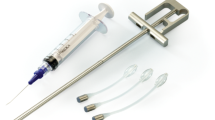Abstract
Midurethral slings may lose their effectiveness due to changes in urethral compression over time in patients with urinary incontinence due to intrinsic sphincter deficiency and neurogenic bladder. Adjustable continence devices offer potential solutions. We reviewed the current literature regarding six adjustable continence devices for male and female patients suffering from incontinence. We reviewed the following devices: Adjustable Continence Therapy® (Uromedica, Irvine, CA), Pro-Adjustable Continence Therapy® for men (Uromedica, Irvine, CA), TRT Remeex (Neomedic, Barcelona, Spain) for females, MRS II Remeex (Neomedic, Barelona, Spain) for men, Argus ®, and Phorbas® adjustable continence therapy for men (Promedon SA, Cordoba, Argentina). Based on the reviewed studies, adjustable continence devices offer similar, if not less, risk than traditional stress urinary incontinence (SUI) procedures with greater outcomes as reported by patients. Adjustable continence devices allow clinicians to adjust urethral tension post-operatively if necessary without secondary procedures and general anesthesia. Adjustable devices are particularly well-suited to SUI with a neurogenic etiology as these devices allow for post-operative adjustments to sphincter pressure from a clinical setting.
Similar content being viewed by others
References
Papers of particular interest, published recently, have been highlighted as: • Of importance
Phe V, Nguyen K, Roupret M, Cardot V, Parra J, Chartier-Kastler E. A systematic review of the treatment for female stress urinary incontinence by ACT(R) balloon placement (Uromedica, Irvine, CA, USA). World J Urol. 2014;32(2):495–505. doi:10.1007/s00345-013-1117-0. Great review of the available devices and their outcomes to date.
Hubner WA, Schlarp OM. Treatment of incontinence after prostatectomy using a new minimally invasive device: adjustable continence therapy. BJU Int. 2005;96(4):587–94. doi:10.1111/j.1464-410X.2005.05689.x.
Sousa-Escandon A, Cabrera J, Mantovani F, Moretti M, Ioanidis E, Kondelidis N, et al. Adjustable suburethral sling (male remeex system) in the treatment of male stress urinary incontinence: a multicentric European study. Eur Urol. 2007;52(5):1473–9. doi:10.1016/j.eururo.2007.05.017.
Kocjancic E, Crivellaro S, Smith 3rd JJ, Ranzoni S, Bonvini D, Frea B. Adjustable continence therapy for treatment of recurrent female urinary incontinence. J Endourol. 2008;22(7):1403–7. doi:10.1089/end.2008.0027. Great review of the available devices and their outcomes to date.
Aboseif SR, Franke EI, Nash SD, Slutsky JN, Baum NH, le Tu M, et al. The adjustable continence therapy system for recurrent female stress urinary incontinence: 1-year results of the North America Clinical Study Group. J Urol. 2009;181(5):2187–91. doi:10.1016/j.juro.2009.01.039.
Mehnert U, Bastien L, Denys P, Cardot V, Even-Schneider A, Kocer S, et al. Treatment of neurogenic stress urinary incontinence using an adjustable continence device: 4-year followup. J Urol. 2012;188(6):2274–80. doi:10.1016/j.juro.2012.07.131.
Crivellaro S, Smith JJ. Minimally invasive therapies for female stress urinary incontinence: the current status of bioinjectables/new devices (adjustable continence therapy, urethral submucosal collagen denaturation by radiofrequency). Sci World J. 2009;9:466–78. doi:10.1100/tsw.2009.53. Great review of the available devices and their outcomes to date.
Kocjancic E, Crivellaro S, Ranzoni S, Bonvini D, Grosseti B, Frea B. Adjustable continence therapy for severe intrinsic sphincter deficiency and recurrent female stress urinary incontinence: long-term experience. J Urol. 2010;184(3):1017–21. doi:10.1016/j.juro.2010.05.024.
Kocjancic E, Crivellaro S, Ranzoni S, Bonvini D, Gontero P, Frea B. Adjustable Continence Therapy for the treatment of male stress urinary incontinence: a single-centre study. Scand J Urol Nephrol. 2007;41(4):324–8. doi:10.1080/00365590601153488.
Errando C, Rodriguez-Escovar F, Gutierrez C, Baez C, Arano P, Villavicencio H. A re-adjustable sling for female recurrent stress incontinence and sphincteric deficiency: outcomes and complications in 125 patients using the Remeex sling system. Neurourol Urodyn. 2010;29(8):1429–32. doi:10.1002/nau.20879.
Sousa-Escandon A, Rodriguez Gomez JI, Uribarri Gonzalez C, Marques-Queimadelos A. Externally readjustable sling for treatment of male stress urinary incontinence: points of technique and preliminary results. J Endourol. 2004;18(1):113–8. doi:10.1089/089277904322836776.
Moreno Sierra J, Victor Romano S, Galante Romo I, Barrera Ortega J, Salinas Casado J, Silmi MA. New male sling “Argus” for the treatment of stress urinary incontinence. Arch Esp Urol. 2006;59(6):607–13.
Romano SV, Metrebian SE, Vaz F, Muller V, D’Ancona CA, Costa DE, et al. An adjustable male sling for treating urinary incontinence after prostatectomy: a phase III multicentre trial. BJU Int. 2006;97(3):533–9. doi:10.1111/j.1464-410X.2006.06002.x.
Bauer RM, Herschorn S, Olmedo TB, Reyes OD, Huebner W. V64 The Phorbas system—a new single incision adjustable male sling: implantation technique and first results. Eur Urol Suppl. 2014;13(1):eV64. doi:10.1016/S1569-9056(14)61193-3.
Compliance with Ethics Guidelines
Conflict of Interest
The authors declare that they have no conflicts of interest.
Human and Animal Rights and Informed Consent
This article does not contain any studies with human or animal subjects performed by any of the authors.
Author information
Authors and Affiliations
Corresponding author
Additional information
This article is part of the Topical Collection on Neurogenic Bladder
Rights and permissions
About this article
Cite this article
Nimeh, T., Mufarreh, N., Wadhwa, H. et al. A Review of Adjustable Continence Devices for the Treatment of Stress Urinary Incontinence with Neurogenic Etiology. Curr Bladder Dysfunct Rep 10, 346–349 (2015). https://doi.org/10.1007/s11884-015-0332-5
Published:
Issue Date:
DOI: https://doi.org/10.1007/s11884-015-0332-5




